Decor
Why Isn't the Lunar New Year on the Same Date Every Year?

Were you aware that the Lunar New Year doesn’t fall on a consistent date each year? It’s a captivating detail that sparks our interest. In this piece, we’ll delve into the causes of this yearly change.
The Lunar New Year is based on the lunar calendar, which follows the cycles of the moon, unlike the solar calendar we commonly use. This difference in calendar systems plays a significant role in determining the date of the Lunar New Year.
Additionally, the Lunar New Year falls on the second new moon after the winter solstice, further influencing its date. Cultural and historical reasons, as well as adaptations in different regions, also contribute to the variations in Lunar New Year dates around the world.
Join us as we delve into the fascinating world of lunar calendars and the reasons behind the shifting date of the Lunar New Year.
Key Takeaways
- The Lunar New Year is determined by the lunar calendar, which follows the cycles of the moon.
- The lunar calendar holds deep cultural and spiritual significance and is used by various cultures to determine the date of the Lunar New Year.
- The lunar calendar requires periodic adjustments, including the addition of a leap month, to align with the solar calendar.
- Different regions have adapted the Lunar New Year based on their own traditions and customs, leading to variations in the date of celebration.
Lunar New Year Based on Lunar Calendar
The Lunar New Year, also known as Chinese New Year, is determined by the lunar calendar, which is based on the cycles of the moon. The lunar calendar is a complex system that calculates time based on the moon's phases and positions. It's known for its accuracy in tracking celestial events, including eclipses and solstices. This precision allows for the calculation of the Lunar New Year, which falls on the second new moon after the winter solstice.
The lunar calendar's accuracy is crucial for determining the Lunar New Year, as it ensures that the festival aligns with the moon's natural cycles. This tradition has been followed for centuries, and it holds deep cultural and spiritual significance for many communities around the world. The Lunar New Year is celebrated with various customs and traditions, such as family gatherings, feasting, and the exchange of gifts.
The lunar calendar's accuracy also affects other aspects of life, such as agriculture and astrology. Farmers rely on the lunar calendar to determine the best times for planting and harvesting crops, while astrologers use it to predict celestial events and their impact on human lives.
Difference Between Lunar and Solar Calendars

As we explore the difference between lunar and solar calendars, it becomes evident that the lunar calendar's reliance on the moon's cycles contrasts with the solar calendar's emphasis on the Earth's orbit around the sun. Here are some key differences between the two:
- Lunar vs. Gregorian: The lunar calendar is based on the cycles of the moon, with each month corresponding to one lunar cycle. In contrast, the Gregorian calendar, which is the most widely used solar calendar today, is based on the Earth's orbit around the sun, with each year consisting of approximately 365.25 days.
- Lunar Phases: Lunar calendars mark the different phases of the moon, such as the new moon, first quarter, full moon, and last quarter. These phases are important for determining the dates of lunar celebrations and festivals.
- Celebrations: The lunar calendar is traditionally used in many cultures to determine the timing of important events and festivals, such as the Lunar New Year. These celebrations are often tied to agricultural cycles, such as the beginning of spring or the harvest season.
- Complexity: Due to the differences in the lengths of lunar and solar cycles, the lunar calendar requires periodic adjustments to stay in sync with the solar calendar. This is why the Lunar New Year and other lunar celebrations don't fall on the same date every year according to the Gregorian calendar.
Understanding the differences between lunar and solar calendars is crucial for appreciating the cultural significance and traditions associated with lunar celebrations.
The 12-Month Lunar Cycle
We can understand the 12-month lunar cycle by examining the regular patterns and phases of the moon. The lunar cycle is the time it takes for the moon to complete one orbit around the Earth, which is approximately 29.5 days. This cycle is crucial in determining the date of the Lunar New Year because it's based on the lunar calendar.
Lunar cycle calculations are used to create the lunar calendar, which is widely used in many cultures to determine the dates of religious and cultural events. However, the accuracy of the lunar calendar can be challenging due to the slight variation in the length of the lunar cycle. The actual lunar cycle is approximately 29 days, 12 hours, 44 minutes, and 2.8 seconds. To compensate for this variation, a leap month is added every few years to align the lunar calendar with the solar calendar.
Ensuring the accuracy of the lunar calendar is essential to accurately determine the date of the Lunar New Year. This is achieved through meticulous observations of the moon's phases and precise calculations. While the lunar calendar may not always align with the solar calendar, it remains an important cultural and religious tool in many societies.
Lunar New Year Falls on Second New Moon

To further explore the intricacies of determining the date of the Lunar New Year, we now shift our attention to the fascinating phenomenon that the Lunar New Year falls on the second new moon. This occurrence is influenced by the moon phases and holds great cultural significance.
- The influence of moon phases: The Lunar New Year is based on the lunar calendar, which follows the cycles of the moon. The new moon marks the beginning of the lunar month, and each new moon represents the start of a new lunar cycle. The second new moon is chosen as the date for the Lunar New Year to ensure that it falls within the specific time frame desired by the culture celebrating it.
- Cultural significance: The Lunar New Year is celebrated by various cultures, including the Chinese, Korean, and Vietnamese cultures. It's a time of renewal, family reunions, and paying respects to ancestors. The choice of the second new moon reflects the cultural belief that it's an auspicious time for new beginnings and starting afresh.
- Aligning with agricultural cycles: The selection of the second new moon also takes into consideration the agricultural cycles. In many cultures, the Lunar New Year marks the beginning of the agricultural year, and choosing the second new moon ensures that it aligns with the start of the planting season.
- Variations in the lunar calendar: The lunar calendar is based on the cycles of the moon, which is approximately 29.5 days. However, this can lead to variations in the length of lunar months. To account for this, adjustments are made to the lunar calendar to ensure that the Lunar New Year falls on the second new moon, maintaining the cultural traditions and significance associated with it.
Influence of Moon Phases on Date
The date of the Lunar New Year is determined by the influence of moon phases and their significance in various cultures. The moon's gravitational pull on the Earth's oceans creates tides, and this same influence affects the lunar calendar used to determine the date of the Lunar New Year.
The lunar calendar is based on the cycles of the moon, with each month corresponding to one complete lunar cycle. The New Moon marks the beginning of each month, and the Full Moon occurs in the middle. The Lunar New Year falls on the second New Moon after the winter solstice. This is because the winter solstice is the shortest day of the year, and the New Year celebrations are meant to welcome the return of longer days and the arrival of spring.
To better understand the influence of moon phases on the date of the Lunar New Year, let's take a look at the following table:
| Moon Phase | Significance |
|---|---|
| New Moon | Start of month |
| Waxing Crescent | Growth |
| First Quarter | Progress |
| Waxing Gibbous | Advancement |
| Full Moon | Mid-month |
Interplay Between Lunar and Solar Calendars

The interplay between lunar and solar calendars is a fascinating aspect of the Lunar New Year. Lunar cycles are based on the phases of the moon, while solar cycles are based on the Earth's orbit around the sun. These two different cycles have a significant impact on the dates of the festival each year.
The lunar calendar follows a 12-month cycle of approximately 354 days, while the solar calendar follows a 365-day cycle. This difference in length means that the lunar calendar falls behind the solar calendar by about 11 days each year. To account for this discrepancy, a leap month is added to the lunar calendar approximately every three years.
Understanding the interplay between these two calendars is key to understanding why the Lunar New Year falls on different dates each year. The festival is celebrated on the second new moon after the winter solstice, which can vary from late January to late February in the Gregorian calendar.
Lunar Vs. Solar Cycles
The intricate dance between the lunar and solar cycles gives rise to the ever-changing dates of Lunar New Year. Understanding the interplay between these two cycles is crucial in comprehending why the Lunar New Year doesn't fall on the same date every year.
- The lunar cycle length: The lunar cycle is approximately 29.5 days, which is the time it takes for the moon to complete one orbit around the Earth. This cycle forms the basis of the lunar calendar.
- Lunar calendar accuracy: While the lunar calendar aligns with the phases of the moon, it doesn't precisely match the solar year, which is approximately 365.25 days. As a result, the lunar calendar falls behind the solar calendar by about 11 days each year.
- Solar calendar dominance: The solar calendar, which is commonly used in the Western world, determines the dates of holidays like New Year's Day. Its dominance over the lunar calendar contributes to the shifting dates of Lunar New Year.
- Intercalation: To reconcile the discrepancy between the lunar and solar calendars, intercalation, the insertion of extra days or months, is used in some lunar calendar systems. This helps ensure that important events, like Lunar New Year, are celebrated at the appropriate time.
Impact on Festival Dates
As we explore the impact of the interplay between the lunar and solar calendars on festival dates, it becomes evident that the intricate dance between these two cycles plays a significant role in determining the ever-changing dates of Lunar New Year. Lunar calendar traditions and cultural celebrations are deeply rooted in the lunar cycle, which lasts for approximately 29.5 days. However, since the Earth's orbit around the Sun takes about 365.25 days, adjustments need to be made to align the lunar and solar calendars. This is achieved through the use of intercalary months or leap months, which are added periodically to maintain synchronization. The intercalary months ensure that the lunar calendar remains in harmony with the solar calendar, allowing Lunar New Year to occur at different times each year. The following table illustrates the interplay between the lunar and solar calendars in determining the dates of Lunar New Year:
| Year | Lunar Calendar (approx.) | Solar Calendar (approx.) |
|---|---|---|
| 2022 | February 1 | February 12 |
| 2023 | January 22 | February 1 |
| 2024 | February 10 | February 22 |
| 2025 | January 29 | February 10 |
Cultural and Historical Reasons for Lunar Calendar Usage

Cultural and historical reasons play a significant role in the usage of the lunar calendar.
One key reason is the connection between lunar cycles and seasons, which were crucial for agricultural societies to determine optimal planting and harvesting times.
Additionally, the lunar calendar allows for adjustments to be made to account for the slight variations in the length of the lunar month, ensuring the calendar remains aligned with astronomical events.
These cultural and historical reasons demonstrate the practicality and relevance of the lunar calendar in various societies throughout history.
Lunar Cycles and Seasons
Throughout history, societies around the world have relied on lunar cycles and seasons as the foundation for their cultural and historical lunar calendar systems. The accuracy of the lunar calendar is crucial for various reasons, particularly its impact on agricultural practices.
Here are four key aspects to consider:
- Lunar Cycles: The lunar calendar is based on the cycles of the moon, which is approximately 29.5 days long. By tracking these cycles, societies could determine the optimal time for planting and harvesting crops, ensuring the best possible agricultural outcomes.
- Seasonal Changes: Lunar calendars also take into account the changing seasons. By aligning the calendar with the natural rhythm of the Earth's seasons, societies could plan their agricultural activities accordingly, maximizing productivity.
- Festivals and Traditions: Lunar cycles and seasons often coincide with important festivals and cultural traditions. These celebrations are deeply rooted in agricultural practices and have been passed down through generations, preserving cultural heritage and reinforcing community bonds.
- Astrological Significance: In many cultures, lunar cycles and seasons are believed to have astrological significance. People associate specific traits and characteristics with each lunar year, shaping their beliefs, customs, and even personal decisions.
The reliance on lunar cycles and seasons in lunar calendars highlights the deep connection between human societies and the natural world, particularly in regards to agriculture and cultural traditions.
Lunar Calendar Adjustments
The usage of lunar calendars throughout history has necessitated adjustments to account for cultural and historical reasons.
Lunar calendar adjustments are made to align the lunar cycles with the seasons, as well as to accommodate cultural traditions and religious observances.
The lunar calendar is based on the cycles of the moon, which is approximately 29.5 days long. However, the Earth's orbit around the sun is about 365.25 days, resulting in a misalignment between lunar months and solar years.
To reconcile this discrepancy, various methods have been employed, such as adding intercalary months or days to the lunar calendar. These adjustments ensure that important events, such as the Lunar New Year, fall within specific seasons and coincide with significant cultural celebrations.
Adaptations in Different Cultures and Regions

Across various cultures and regions, the Lunar New Year undergoes adaptations that reflect the unique traditions and practices of each community. This celebration, also known as Chinese New Year or Spring Festival, isn't only observed in China but also in many other Asian countries and communities around the world. These adaptations in different cultures and regions highlight the cultural diversity and rich history associated with the Lunar New Year.
- The Lion Dance: In countries like China, Malaysia, and Singapore, the Lion Dance is a popular Lunar New Year tradition. This vibrant and energetic performance involves dancers dressed as lions, accompanied by the rhythmic beats of drums and cymbals. It's believed to drive away evil spirits and bring good luck for the coming year.
- Food and Feasting: Each culture has its own culinary traditions associated with the Lunar New Year. In China, dumplings symbolize wealth and prosperity, while in Korea, tteokguk (rice cake soup) is a must-have dish. In Vietnam, bánh chưng (sticky rice cake) is prepared to honor ancestors and welcome good fortune.
- Red Envelopes: The tradition of giving red envelopes with money inside is a common practice during the Lunar New Year. In China, these envelopes are given to children and unmarried adults as a gesture of good luck and blessings for the year ahead.
- Fireworks and Firecrackers: The use of fireworks and firecrackers is a widespread tradition during the Lunar New Year. It's believed that the loud noises scare away evil spirits and bring good luck. In recent years, however, due to safety concerns and environmental issues, some regions have restricted or banned the use of fireworks.
These adaptations in modern society showcase the cultural diversity and unique celebrations associated with the Lunar New Year. As communities around the world embrace their own traditions and practices, the Lunar New Year continues to evolve, keeping its significance and spirit alive.
Variations in Lunar New Year Dates Around the World

The dates of the Lunar New Year vary each year due to the complex calculations involving the lunar calendar and astronomical observations. These variations are observed not only within different cultures and regions but also across the world.
Lunar New Year celebrations and traditions are deeply rooted in the lunar calendar, which follows the cycles of the moon. However, the lunar calendar is shorter than the solar calendar, which is commonly used in the Western world. This difference in calendars leads to variations in the dates of the Lunar New Year.
In many Asian countries, such as China, Vietnam, and South Korea, the Lunar New Year is celebrated based on the lunisolar calendar. This calendar combines the lunar phases with the solar year, ensuring that the Lunar New Year falls within a specific range of dates. However, within this range, the exact date of the Lunar New Year can still differ. This is because determining the exact moment when the new moon occurs requires precise astronomical observations.
Moreover, different cultures and regions have their own customs and traditions that influence the timing of Lunar New Year celebrations. For example, in China, the Lunar New Year is celebrated on the first day of the lunar calendar, which can vary between January 21 and February 20. In contrast, in Vietnam, the Lunar New Year, known as Tet, is celebrated based on the Vietnamese zodiac, which follows a 12-year cycle. As a result, the date of Tet may differ from the Lunar New Year observed in other countries.
Importance of Tradition and Cultural Significance

The Lunar New Year holds immense importance in many cultures. Its significance goes beyond just a date on the calendar. It's a time for families to come together, for honoring ancestors, and for celebrating the traditions and customs that have been passed down through generations.
The complexities of the lunar calendar and the astronomical calculations involved in determining the date further highlight the depth of cultural significance attached to this annual event.
Lunar Calendar Complexities
Lunar calendar complexities arise from the intricate interplay between tradition and cultural significance, shaping the ever-shifting dates of the Lunar New Year. The lunar calendar accuracy is one of the primary factors contributing to these complexities. It's based on the moon's phases, which don't align perfectly with the solar calendar. This misalignment creates variations in the lunar year's length, making it necessary to periodically adjust the calendar to stay in sync with the solar year.
Additionally, cultural factors play a significant role in determining the Lunar New Year's date. Different cultures and regions have their own customs and beliefs, resulting in variations in the way the lunar calendar is followed and celebrated. Some cultures consider the first new moon after the winter solstice as the start of the lunar year, while others use astrological calculations or traditional agricultural practices.
The lunar calendar complexities also stem from the cultural significance attached to specific lunar phases. For example, the Lunar New Year is often associated with the first new moon after the second full moon following the winter solstice. This connection to specific lunar phases adds depth and meaning to the celebration, but it also contributes to the shifting dates of the Lunar New Year.
Astronomical Calculations Involved
One must consider the intricate astronomical calculations involved in determining the date of the Lunar New Year, as these calculations are influenced by both tradition and cultural significance.
The Lunar New Year follows the lunar calendar, which is based on the cycles of the moon. The lunar calendar calculations take into account the phases of the moon and the position of the sun, as well as the traditional customs and practices associated with the celebration.
The date of the Lunar New Year is determined by the second new moon after the winter solstice, which usually falls between January 21 and February 20. This calculation ensures that the Lunar New Year aligns with the agricultural and seasonal changes, as well as the cultural and religious observances of various communities.
Therefore, the astronomical significance of the Lunar New Year is deeply rooted in the traditions and cultural practices of different societies.
Frequently Asked Questions
How Is the Date of the Lunar New Year Determined?
The date of the Lunar New Year is determined by the lunar calendar, which differs from the Gregorian calendar. Unlike the Gregorian calendar, which follows a solar cycle, the lunar calendar is based on the phases of the moon. This means that the date of the Lunar New Year can vary each year.
In addition to the Lunar New Year, other holidays such as Ramadan and Diwali are also celebrated based on the lunar calendar.
What Is the Significance of the Second New Moon in Determining the Date of the Lunar New Year?
The significance of the second new moon in determining the date of the Lunar New Year lies in the traditions of the lunar calendar. In this calendar system, the new moon marks the start of a new month.
The second new moon after the winter solstice is considered the beginning of spring, and thus, the Lunar New Year. This astrological significance ensures that the Lunar New Year aligns with the natural cycles of the moon and seasons.
This unique and culturally significant celebration holds great importance in many Asian cultures. It is a time for family gatherings, feasting, and honoring ancestors. The Lunar New Year also symbolizes new beginnings, good fortune, and the opportunity for personal growth.
How Do Moon Phases Influence the Date of the Lunar New Year?
Moon phase effects play a crucial role in the calculation of the Lunar New Year. The date of the Lunar New Year is determined by the second new moon after the winter solstice. This is because the lunar calendar follows the cycles of the moon, and the second new moon represents the beginning of a new lunar month.
Are There Any Cultural or Historical Reasons Behind the Use of the Lunar Calendar?
Cultural traditions and lunar festivals hold deep significance in our history. The use of the lunar calendar is rooted in ancient practices and beliefs, connecting us to our ancestors. By following the moon's cycles, we honor the natural rhythms of life and celebrate the changing seasons.
The lunar calendar also allows for the observation of various celestial events, marking important occasions and guiding our agricultural activities. Understanding the cultural and historical reasons behind the lunar calendar enriches our understanding of our heritage.
Why Do Different Cultures and Regions Celebrate the Lunar New Year on Different Dates?
Different cultures and regions celebrate the lunar new year on different dates due to a combination of cultural traditions and lunar calendar variations.
The lunar new year is based on the cycles of the moon, which can vary in length.
Additionally, different cultures may have their own unique ways of calculating the date, taking into account astronomical observations and cultural practices.
These variations add richness and diversity to the celebration, reflecting the unique customs and beliefs of each culture.
Why Is the Lunar New Year Date Not Fixed Like the New York Times Crossword?
The Lunar New Year date is not fixed like the New York Times Crossword, making it a challenge for many to plan ahead. This unpredictability makes it the hardest day for crossword enthusiasts to schedule festive celebrations. The shifting date adds an element of surprise to an already unpredictable holiday.
Conclusion
In conclusion, the lunar new year isn't on the same date every year due to its basis on the lunar calendar, which differs from the solar calendar. The lunar new year falls on the second new moon, and the date is influenced by the moon phases.
This variation in dates is influenced by cultural and historical reasons, leading to adaptations in different cultures and regions. Despite the variations, the importance of tradition and cultural significance remains constant, making the lunar new year a cherished celebration worldwide.
- About the Author
- Latest Posts
Introducing Ron, the home decor aficionado at ByRetreat, whose passion for creating beautiful and inviting spaces is at the heart of his work. With his deep knowledge of home decor and his innate sense of style, Ron brings a wealth of expertise and a keen eye for detail to the ByRetreat team.
Ron’s love for home decor goes beyond aesthetics; he understands that our surroundings play a significant role in our overall well-being and productivity. With this in mind, Ron is dedicated to transforming remote workspaces into havens of comfort, functionality, and beauty.
Southeast Asia Decor
Stop Ignoring Balance in Your Feng Shui Design
With the right balance in your Feng Shui design, you can unlock opportunities and personal growth—discover how to transform your space effectively.

If you're ignoring balance in your Feng Shui design, you're disrupting the flow of Chi energy. This imbalance can lead to clutter, chaos, and stagnation, holding back your personal growth and opportunities. To create a harmonious space, incorporate both Yin and Yang elements, blending soft textures with bold shapes. Utilize the Bagua map to target specific areas like wealth and relationships, and make sure to clear clutter regularly. By focusing on these aspects, you'll foster a serene environment that enhances well-being. There's plenty more to explore on achieving harmony in your home that can transform your life.
Key Takeaways
- Achieve harmony by blending Yin and Yang energies through thoughtful color and texture choices in your space.
- Regularly assess your Bagua map to identify and activate areas needing balance for improved life aspects.
- Remove clutter to facilitate smooth Chi flow, promoting personal growth and emotional clarity.
- Incorporate the Five Elements in your design to create a serene and well-rounded environment.
- Use natural light and air-purifying plants to enhance positive energy and support emotional stability.
Understanding Balance in Feng Shui

To grasp balance in Feng Shui, you need to immerse yourself in the interplay of Yin and Yang. This ancient philosophy teaches that Yin, representing nurturing energy, and Yang, embodying active energy, must harmonize to create a positive living environment.
Your space needs to reflect this balance for ideal energy flow. Incorporating elements from Indonesian decorative pillows can add vibrant colors and intricate patterns that enhance the overall harmony in your space.
Utilizing the Bagua map can help you identify areas of imbalance in your home. Each of the nine life areas corresponds to specific elements, colors, and intentions. When these elements align, you enhance the flow of Chi energy, promoting liveliness and well-being.
Clutter is a significant barrier to balance; it disrupts the flow of Chi and leads to stagnation. By maintaining a clutter-free environment, you allow positive energy to circulate freely throughout your space.
Additionally, pay attention to furniture placement—arranging pieces thoughtfully creates open spaces and guarantees no furniture looms over you, fostering a sense of safety and relaxation.
Incorporating these principles of Feng Shui into your design will help cultivate a harmonious atmosphere, allowing you to thrive in your environment.
Key Elements of Yin and Yang

Yin and Yang are essential forces that shape the energy dynamics of your space. These dual forces create a balanced energy dynamic, with Yin embodying femininity, darkness, and receptivity, while Yang represents masculinity, light, and activity.
In Feng Shui, achieving a harmonious balance between Yin and Yang is vital for promoting positive energy flow. If there's too much of one, it can lead to stagnation or chaos in your environment. Incorporating natural materials and earthy tones, as seen in Balinese Interior Design concepts, can enhance the feeling of balance and tranquility in your space.
The Five Elements—Wood, Fire, Earth, Metal, and Water—each have Yin and Yang characteristics. Elements like Water and Earth are more Yin, while Fire and Metal lean towards Yang. Balancing these elements in your space enhances the overall energy flow.
Your choices in placement and color also influence this balance. Softer colors and rounded shapes promote Yin energy, while brighter colors and angular shapes boost Yang energy.
By regularly evaluating and adjusting the balance of Yin and Yang, you can considerably improve your emotional well-being. This practice helps create a tranquil and invigorating atmosphere, fostering overall harmony in your life.
Common Imbalances and Their Effects

Imbalances in Yin and Yang energies can greatly disrupt your emotional well-being and overall harmony within a space. In Feng Shui, achieving balance is essential for fostering positive energy and ensuring that Chi flows freely.
This concept is similarly reflected in traditional Indonesian housing, where the design promotes community and sustainability through natural materials and elevated structures traditional housing principles.
Here are three common imbalances you might encounter:
- Clutter: This blocks the flow of Chi, leading to stagnation in your life. When your living space is cluttered, it can hinder personal growth and opportunities, making you feel stuck.
- Excess Yang Energy: Too much Fire without the balancing element of Water can create chaos. This imbalance might heighten stress or aggression, causing discomfort in your environment.
- Misaligned Bagua Map: Neglecting the proper alignment of the Bagua map with your front door can impact specific areas of your life, like wealth or relationships. This misalignment can lead to instability and affect overall prosperity.
Practical Tips for Achieving Balance

Achieving balance in your space is essential for creating a harmonious environment where positive energy can thrive. Start by incorporating the five elements of Feng Shui—Wood, Fire, Earth, Metal, and Water. Make sure each element is represented in your important rooms to promote overall harmony and well-being. For instance, using natural materials such as wood and stone can enhance your decor while aligning with traditional Indonesian style home decor.
Next, blend Yin and Yang energy by mixing soft textures and calming colors with bold shapes and vibrant hues. This approach fosters a balanced emotional atmosphere. Use the Bagua map to assess different areas of the home, ensuring each section is activated with suitable colors, elements, and decor that resonate with your personal goals.
One of the most important steps is to remove clutter. A clutter-free environment supports the smooth flow of energy, known as Chi, while clutter disrupts balance and creates stagnant energy.
Enhancing Your Space With Harmony

Creating a harmonious space involves thoughtfully blending the five elements of Feng Shui—Wood, Fire, Earth, Metal, and Water—to foster a serene environment. Each element brings specific colors and emotions that promote well-being and positive energy.
To enhance your space with harmony, consider these three tips:
1. Use the Bagua Map: Identify areas in your home that correspond to different life aspects. Enhance these areas with the appropriate elements and colors to improve energy flow and balance.
Additionally, consider incorporating traditional cultural elements, such as vibrant color palettes and intricate designs, which can further enrich the ambiance and reflect your personal style, like Indonesian wedding decor ideas.
2. Incorporate Natural Light and Plants: Maximize natural light to invigorate your space, and include air-purifying plants. This not only promotes positive Chi but also creates a lively atmosphere.
3. Avoid Clutter: Regularly evaluate your space to eliminate clutter. Keeping your environment organized aids in maintaining positive energy, enhancing emotional clarity and stability, and fostering a sense of balance.
Frequently Asked Questions
How Do You Balance in Feng Shui?
To balance in Feng Shui, you'll need to harmonize Yin and Yang energies, incorporate the Five Elements, and use the Bagua map. Regularly assess furniture placement and guarantee natural light and airflow flow freely.
What Does Feng Shui Say About Clutter?
Imagine walking into a room stuffed with old magazines. Feng Shui says clutter blocks Chi energy, leading to stagnation. By decluttering, you enhance flow, boost clarity, and create a serene space that nourishes your well-being.
What Is Bad Feng Shui in a House?
Bad Feng Shui in your house includes clutter blocking energy flow, misaligned doors and windows allowing Chi to escape, sharp corners creating discomfort, and prominent bathrooms symbolizing energy drains. Broken items also disrupt your home's positive energy.
What Colors Should Be Avoided in Feng Shui?
In Feng Shui, avoid excessive red, bright white, and black, as they can disrupt energy balance. Also, steer clear of overly bright colors and too many earthy tones to maintain a vibrant, harmonious space.
Conclusion
In the dance of life, balance is your partner, guiding each step with grace. Just as a tree thrives when its roots and branches harmonize, your space flourishes when yin and yang coexist. By tuning into the rhythms of your environment and addressing imbalances, you cultivate a sanctuary that nurtures your spirit. Embrace this journey, and watch as your surroundings transform into a symphony of peace, inviting prosperity and joy into every corner of your life.
- About the Author
- Latest Posts
Introducing Ron, the home decor aficionado at ByRetreat, whose passion for creating beautiful and inviting spaces is at the heart of his work. With his deep knowledge of home decor and his innate sense of style, Ron brings a wealth of expertise and a keen eye for detail to the ByRetreat team.
Ron’s love for home decor goes beyond aesthetics; he understands that our surroundings play a significant role in our overall well-being and productivity. With this in mind, Ron is dedicated to transforming remote workspaces into havens of comfort, functionality, and beauty.
Southeast Asia Decor
Achieve Harmony With Feng Shui in Your Home
Perfect your living space with feng shui principles to invite positivity and balance; discover how to transform your home into a serene sanctuary.

To achieve harmony with feng shui in your home, start by creating an inviting front door that welcomes positive energy. Declutter your space, as a tidy environment lets chi flow freely. Balance the five elements—earth, metal, water, wood, and fire—using colors and materials to stabilize and energize your surroundings. Embrace nature by incorporating low-maintenance plants to enhance your well-being and purify the air. Finally, use a Bagua Map to pinpoint areas needing improvement and enhance your living spaces. With these steps, you'll transform your home into a peaceful haven, opening the door to more insights and techniques.
Key Takeaways
- Create an inviting front door with natural materials and vibrant colors to welcome positive energy into your home.
- Regularly declutter your space to enhance the flow of chi and promote a calming atmosphere.
- Balance the five feng shui elements throughout your home to achieve overall harmony and stability.
- Incorporate low-maintenance plants to improve air quality and support a healing environment.
- Use a Bagua Map to identify areas needing energy improvement and adjust decor accordingly.
Importance of an Inviting Front Door
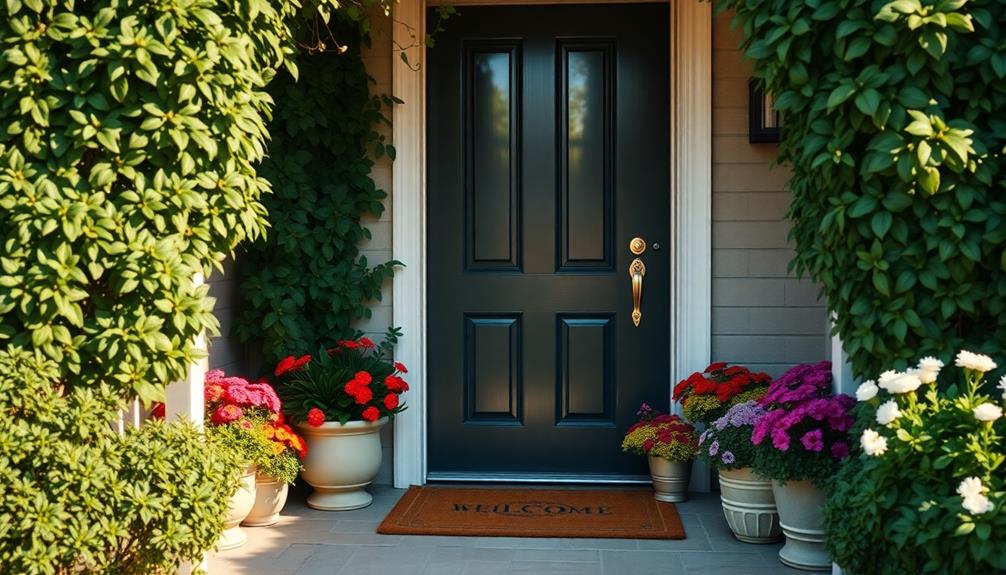
The front door is more than just an entrance; it's the gateway for energy, or chi, into your home. An inviting entrance is essential for attracting positive energy and creating a harmonious home.
If you want to enhance the energy that flows into your space, consider the overall appearance of your front door. A red front door is particularly auspicious, symbolizing fortune and positivity. If painting isn't an option, you can still invite good vibes by placing red flowering plants nearby or using charms that represent good luck.
Additionally, incorporating natural materials and colors inspired by Balinese design characteristics can further enhance the welcoming atmosphere.
Maintaining a clutter-free entrance is important. Regular cleaning and organizing set a welcoming tone, encouraging the smooth flow of energy.
Adequate lighting around the front door also plays a significant role; it not only brightens the space but also enhances the warmth and positivity that radiates from your home.
By focusing on these elements, you create an atmosphere that invites both guests and positive energy, fostering a sense of peace and balance in your life.
Decluttering for Positive Energy

An inviting front door sets the stage for positive energy, but if clutter fills your home, it can block that vital flow of chi. Decluttering is fundamental for maintaining a harmonious environment.
In traditional Indonesian housing, for instance, the layout often reflects a desire for balance and openness, emphasizing the importance of space for energy flow traditional Indonesian housing.
Start with your entryway; it's the first impression of your home and where energy enters. When it's cluttered, it hinders opportunities and makes it challenging to invite positivity.
Regularly removing unused items not only revitalizes your space but also aligns with feng shui principles, promoting a sense of calm and well-being.
Consider using organizational tools like wall hooks for coats and decorative mail holders. These solutions help maintain a clean, clutter-free entryway, encouraging everyone in your household to keep things tidy.
Downsizing and simplifying your belongings can enhance energy flow, creating a serene atmosphere. A clean and spacious entryway sets a welcoming tone, inviting positive energy into your home.
It fosters overall prosperity and happiness. Embrace the art of decluttering, and watch as your living space transforms into a sanctuary of harmony and balance, allowing the chi to flow freely throughout your home.
Balancing the Five Elements
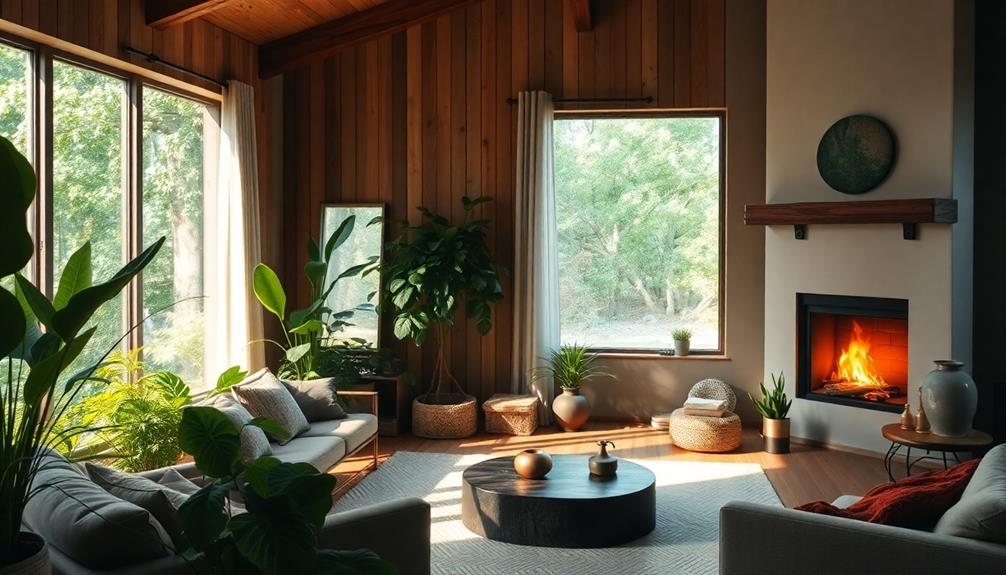
Balancing the five elements of feng shui—earth, metal, water, wood, and fire—creates a dynamic and harmonious environment in your home. Each element contributes unique qualities that enhance the overall energy of your living space. To achieve balance, incorporate these elements through specific materials, colors, and shapes.
For instance, you can use plants to represent wood, aquariums for water, candles for fire, and metal decor for metal. Additionally, consider adding traditional artistry, such as Indonesian decor masks, which can serve as beautiful focal points that enhance aesthetic appeal. Earthy tones, such as browns and beiges, can stabilize energy and promote tranquility, while vibrant reds and oranges associated with fire can energize and uplift your atmosphere.
Regularly assess your living space to verify all five elements are represented. This not only maintains ideal energy flow but also supports your overall well-being. If you notice an imbalance, consider making adjustments, like adding a water feature or repositioning furniture to enhance harmony.
Embracing Nature With Plants
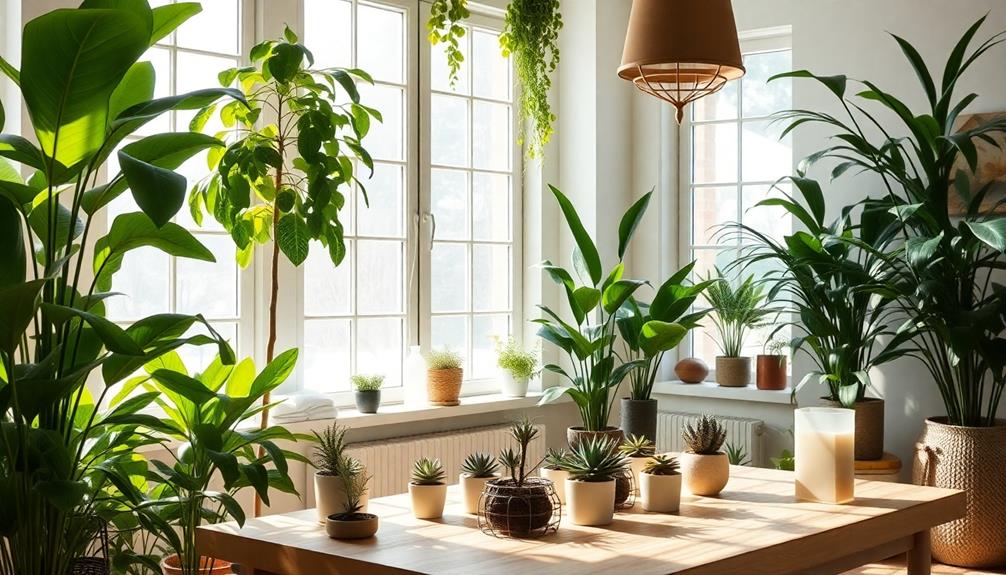
Incorporating plants into your home not only enhances its beauty but also aligns with feng shui principles to create a vibrant and healing environment. Choose low-maintenance options like aloe vera and lucky bamboo, as they're perfect for promoting harmony.
You can also consider adding Indonesian decorative pillows to complement the natural elements, creating a cozy atmosphere. Rounded-leaf plants, in particular, help foster serenity and positive energy flow, while sharp or prickly plants can create discomfort and anxiety.
Healthy plants improve indoor air quality, rejuvenating your atmosphere and supporting overall well-being. To maintain a balanced energy in your home, it's essential to regularly tend to your plants; dead or wilting ones can weaken the energy and disrupt the peaceful vibe you want to achieve.
Strategically place plants in key areas, like your entryway or living room, to activate positive chi. This not only enhances aesthetics but also creates a harmonious balance among the five feng shui elements.
Enhancing Your Living Space

Creating a harmonious living space hinges on the careful integration of the five feng shui elements—earth, metal, water, wood, and fire—into your decor and arrangement. Start by utilizing a Bagua Map to identify areas of your home that need energy improvement. Incorporate colors and materials that resonate with these elements; for example, choose calming tones for relaxation areas and vibrant hues for social spaces.
You might also consider incorporating traditional Indonesian style home decor to enhance the natural ambiance of your space.
When placing your bed, make sure it's positioned for ideal energy flow, avoiding direct alignment with doors, which can disrupt peace. Add little feng shui touches like rounded-leaf plants, such as lucky bamboo, to enhance liveliness and promote harmony in your home.
Regularly declutter your living area to maintain smooth energy movement, as excess items can create a sense of heaviness and imbalance. Arrange furniture to facilitate open traffic flow, making certain that energy can circulate freely.
Remember the fire element; incorporate candles or warm lighting to add warmth and passion to your space. By focusing on these elements, you'll be well on your way to creating balance and harmony in your living environment.
Frequently Asked Questions
How to Use Feng Shui in Your Home?
To use feng shui in your home, declutter regularly, position your furniture for a commanding view, incorporate the five elements, and enhance energy flow with bright colors and decor that resonates with your life goals.
How to Bring Positive Energy Into Your Home Feng Shui?
Did you know that 75% of people feel more energized in a decluttered space? To invite positive energy, keep your entryway tidy, use vibrant colors, and incorporate all five elements for a balanced atmosphere.
What Is the Feng Shui Belief in House?
Feng Shui believes that your home's layout and design impact your life energy. By arranging spaces thoughtfully, you can enhance well-being, attract opportunities, and create a harmonious environment that supports your goals and aspirations.
How Do I Know if My House Is Good Feng Shui?
To know if your house has good feng shui, check for clutter-free pathways, balanced elements, and a welcoming entrance. Confirm key furniture is in commanding positions and use the Bagua map to assess energy flow.
Conclusion
By embracing the principles of feng shui, you're not just rearranging your home; you're cultivating a sanctuary that breathes positivity and balance. Just as a river flows more freely when it's clear of obstacles, your space can thrive without clutter and disharmony. Invite nature in, harmonize the elements, and let your front door welcome abundance. As you create this inviting environment, you'll find that tranquility and joy naturally follow, turning your house into a true home.
- About the Author
- Latest Posts
Introducing Ron, the home decor aficionado at ByRetreat, whose passion for creating beautiful and inviting spaces is at the heart of his work. With his deep knowledge of home decor and his innate sense of style, Ron brings a wealth of expertise and a keen eye for detail to the ByRetreat team.
Ron’s love for home decor goes beyond aesthetics; he understands that our surroundings play a significant role in our overall well-being and productivity. With this in mind, Ron is dedicated to transforming remote workspaces into havens of comfort, functionality, and beauty.
Southeast Asia Decor
Create Harmonious Spaces for Peaceful Living
Harmonize your living spaces to foster tranquility and well-being; explore essential tips that can transform your home into a peaceful sanctuary.
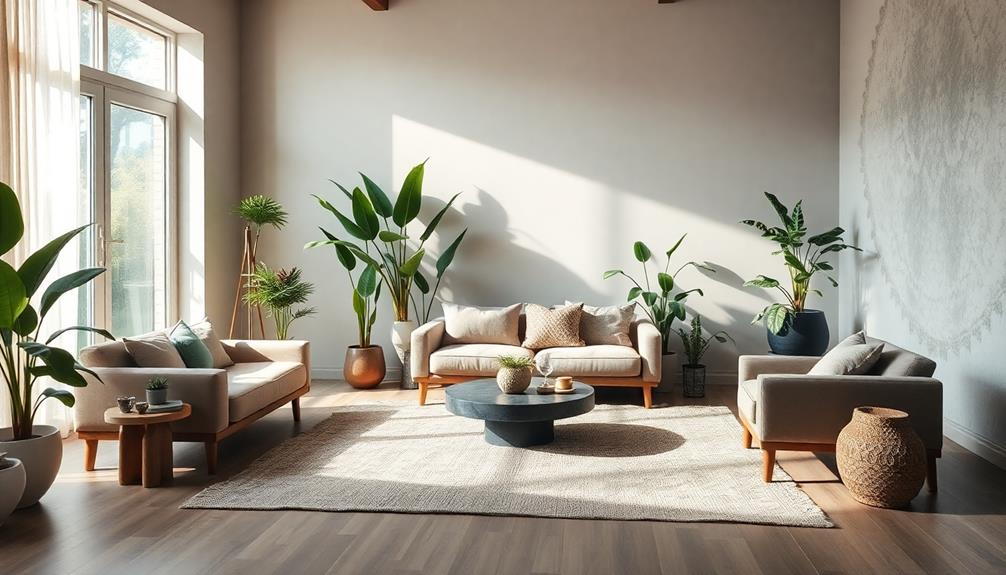
To create harmonious spaces for peaceful living, start by decluttering your home. Sort items into keep, donate, and discard categories to reduce visual chaos. Incorporate natural materials, like wood and stone, to promote a grounding effect while adding houseplants for improved air quality. Use soft textiles and warm lighting to invite comfort and relaxation. You can enhance your serenity with calming routines and mindful practices, such as focused breathing. Consider integrating CBD products to reduce stress and foster tranquility. Discover more ways to cultivate a peaceful environment that enhances your well-being and quality of life.
Key Takeaways
- Choose soothing colors and natural materials in your decor to foster a calming atmosphere that enhances relaxation.
- Declutter regularly by sorting items into keep, donate, and discard categories, creating a peaceful and organized environment.
- Incorporate houseplants and soft textiles to improve air quality and invite comfort into your living spaces.
- Utilize warm lighting and calming scents, like lavender, to transform your home into a serene sanctuary.
- Integrate mindfulness practices and calming routines to manage stress and promote overall well-being in your daily life.
Importance of a Peaceful Home

Creating a peaceful home can be your sanctuary, greatly impacting your mental, emotional, and physical well-being. A harmonious environment fosters relaxation and stress reduction, allowing you to recharge after a hectic day. Thoughtful design choices, like soothing color palettes, calming décor, and natural materials contribute to a comforting atmosphere that supports your daily life balance.
To achieve a peaceful home, prioritize maintaining a clutter-free space. Excessive clutter can overwhelm you, leading to anxiety and hindering your emotional well-being. By organizing your belongings and creating dedicated relaxation areas, you can cultivate a sense of tranquility that promotes restorative practices.
Incorporating natural elements, such as houseplants and organic materials, not only enhances air quality but also instills a sense of calm. These elements connect you with nature, further enriching your peaceful home.
Ultimately, your space should reflect the serenity you desire. By making intentional design choices and prioritizing a calming atmosphere, you can create a sanctuary that nurtures your mental well-being and enhances your overall quality of life.
Embrace the importance of a peaceful home and watch as it transforms your experience of daily living.
Decluttering and Organizing Spaces

Clutter can creep into your life, making it hard to maintain the peaceful sanctuary you desire. By embracing decluttering and organizing, you can create a serene environment that promotes mental clarity and overall well-being.
Start with a mindful evaluation of each room, identifying areas that need attention. Consider integrating elements of Indonesian decorative pillows to enhance comfort and reflect cultural heritage in your space. This intentional approach supports minimalist living, helping you focus on what truly matters.
Implement effective strategies like sorting items into keep, donate, and discard categories. This not only reduces visual chaos but also streamlines your living space.
Consider adopting the "one in, one out" rule; for every new item you bring in, let go of an existing one. This practice encourages mindful consumption and keeps your home organized.
Designated storage solutions, such as baskets and shelves, can greatly enhance your space. They make it easier to find and access items when needed, further reducing stress.
As you declutter, you'll notice a transformation in your environment—one that fosters order and harmony. By prioritizing these practices, you cultivate a peaceful sanctuary that nurtures your spirit and enhances your daily life.
Calming Elements for Serenity

A serene environment goes beyond just decluttering; it also involves incorporating calming elements that foster tranquility and relaxation.
Start by integrating natural materials like wood and stone into your decor, similar to the traditional Indonesian housing that utilizes local materials for a grounding effect. These elements create a grounding effect, enhancing your connection with the earth and promoting feelings of serenity.
Adding houseplants not only improves air quality but also infuses vibrancy into your space. Studies show that indoor greenery can greatly reduce stress levels and boost your mood.
Next, consider soft textiles. Plush blankets and cushions invite comfort, creating a cozy atmosphere that encourages you to unwind.
Pair these with soft, warm lighting to transform your room's ambiance. This lighting fosters a welcoming environment, reducing anxiety and promoting a peaceful environment.
Enhancing Harmony With CBD
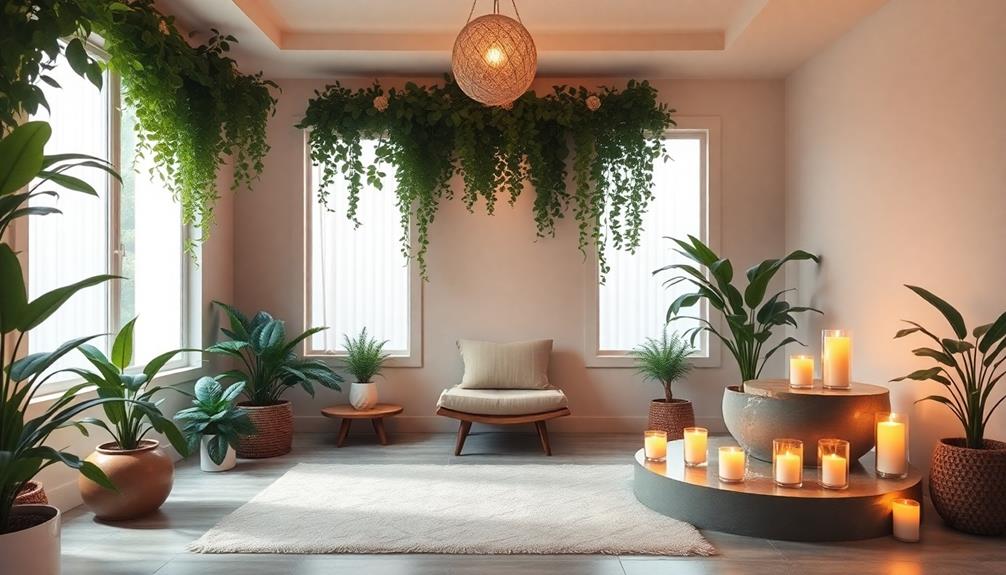
Incorporating CBD into your daily routine can greatly enhance the tranquility of your living space. By creating a serene environment, you foster relaxation and promote well-being. Integrating elements of traditional artistry through decor, such as Indonesian masks, can also add to the calming aesthetics of your home.
CBD products, such as oils, gummies, and topical rubs, work wonders in reducing stress levels and supporting mental clarity. When you integrate these items into your wellness rituals—like calming teas or relaxation routines—you invite a sense of peace and harmony into your life.
Regular use of CBD can notably improve your sleep quality, allowing for deeper rest and recovery. This restoration is essential for maintaining a peaceful home atmosphere. Additionally, CBD's anti-inflammatory properties help alleviate body aches and discomfort, further enhancing your physical ease and contributing to a tranquil living space.
As you explore the benefits of CBD, you'll find it not only aids in stress reduction but also evokes positive emotions that enhance the overall calming effects of your environment. Embracing CBD can be a powerful step toward creating harmonious spaces that support your peaceful living journey.
Strategies for Stress Management

How can you effectively manage stress in today's fast-paced world? Implementing a few simple strategies can transform your environment into a peaceful atmosphere, promoting inner peace and mental well-being.
Start by incorporating mindfulness practices like focused breathing or meditation; these techniques can considerably reduce stress levels and enhance mental clarity. Additionally, creating a serene and inviting space using expert tropical design can further contribute to a calming environment.
Here are three effective strategies for stress management:
- Aromatherapy: Use essential oils like lavender and chamomile to create a calming environment that fosters relaxation.
- Digital Detox: Set boundaries for device usage. Taking breaks from screens helps combat tech-related stress, allowing your mind to refocus.
- Creating a Calming Routine: Establish an evening ritual that includes activities like reading or sipping herbal teas. This can greatly improve sleep quality, which is vital for effective stress management.
Frequently Asked Questions
How Do You Make a Peaceful Living Space?
To make a peaceful living space, declutter often, use calming colors, and incorporate natural materials. Soft lighting and soothing scents can enhance relaxation, while textured fabrics engage your senses, creating a serene atmosphere you'll love.
How Do You Make a Harmonious Space?
To make a harmonious space, you declutter regularly, incorporate calming colors, engage with nature, optimize lighting, and personalize your environment. Each action enhances comfort, fosters tranquility, and creates a welcoming atmosphere you'll love.
What Is a Harmonious Living Environment?
A harmonious living environment feels balanced and serene. You'll notice soothing colors, natural elements, and organized spaces that reduce distractions. Engaging your senses with soft lighting and calming scents enhances your overall well-being and tranquility.
How Do You Create a Tranquil Environment?
To create a tranquil environment, use calming colors, natural materials, and soft lighting. Add houseplants for a touch of nature, and follow the one in, one out rule to keep clutter at bay.
Conclusion
Creating a harmonious space for peaceful living isn't just about aesthetics; it's about nurturing your well-being. Remember, "a cluttered desk is a cluttered mind." By decluttering, incorporating calming elements, and using strategies like CBD to manage stress, you're setting the stage for tranquility. Embrace these changes, and watch how your home transforms into a sanctuary. With each step you take, you'll cultivate a peaceful environment that nourishes your soul and enhances your everyday life.
- About the Author
- Latest Posts
Introducing Ron, the home decor aficionado at ByRetreat, whose passion for creating beautiful and inviting spaces is at the heart of his work. With his deep knowledge of home decor and his innate sense of style, Ron brings a wealth of expertise and a keen eye for detail to the ByRetreat team.
Ron’s love for home decor goes beyond aesthetics; he understands that our surroundings play a significant role in our overall well-being and productivity. With this in mind, Ron is dedicated to transforming remote workspaces into havens of comfort, functionality, and beauty.
-

 Retreat4 weeks ago
Retreat4 weeks agoDIY Aromatherapy Diffusers for a Spa-Like Atmosphere at Home
-

 Retreat3 weeks ago
Retreat3 weeks agoThe Business of Retreats: Marketing Strategies for Success
-
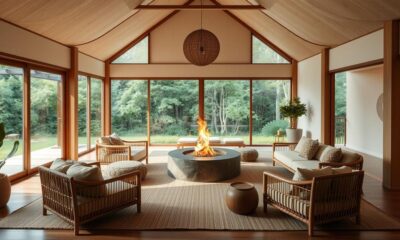
 Retreat3 weeks ago
Retreat3 weeks ago10 Unique Themed Room Ideas for Your Retreat Center
-

 Retreat2 weeks ago
Retreat2 weeks agoThe Pros and Cons of Different Retreat Center Business Models
-

 Southeast Asia Decor3 weeks ago
Southeast Asia Decor3 weeks agoIndonesian Textiles Shaping Contemporary Interior Design
-

 Retreat3 weeks ago
Retreat3 weeks agoHow to Host a Successful Wellness Retreat: A Complete Guide
-

 Retreat4 weeks ago
Retreat4 weeks agoThe Psychology of Color in Retreat Center Design
-

 Retreat4 weeks ago
Retreat4 weeks agoHow to Create a Zen Garden for Your Retreat Center




























